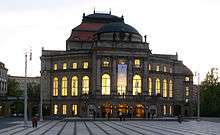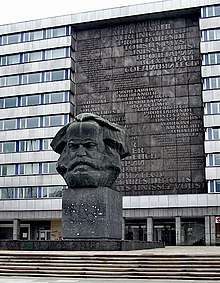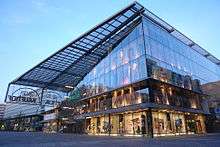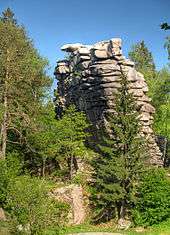Chemnitz
Chemnitz is a city in southwestern Saxony, with around 250 000 inhabitants the third-largest city in the state, after Dresden and Leipzig. The settlement developed around a monastery, and was granted city status in 1170. Due to its location at the foot of the Erzgebirge (literally ore mountains), in the 16th century Chemnitz began to grow in size an importance as a place of trade, and later as the base of industrial production.
The increase in Saxon coal mining during the 18th century allowed Chemnitz to develop into one of the most important centres of the German machine and textile industries - factors which gave it the nickname of "little Manchester". Several large areas of the city were built during this period including Kaßberg and Sonnenberg. Due to the economic importance of Chemnitz it was a prime target for the Allied air force during World War II. By 1945 the city had undergone near to total destruction. Between 1953 and 1990 Chemnitz was renamed as Karl-Marx-Stadt (even though Marx had never visited nor had anything to do with the city's contemporary history). A great deal of new building occurred during this period, much of which remains today. The large bronze head was presented to the town's people in 1971.

Understand
Unlike Berlin and Leipzig, Chemnitz has experienced much less of demolition and rebuilding since the reunification. Modern buildings like the new department store, communist era flats and more historic buildings are within walking distance of each other. Parts of Chemnitz allow a glimpse into how a city of the East Germany felt and looked, something that is increasingly hard to find in other parts of the former East.
Even with this the centre of Chemnitz has been described as "Germany's most recent city centre". The initial commercial investment after reunification focussed on large out-of-town shopping centres, and it wasn't until 1999 that major building activity started in the city centre. Comparable only to Potsdamer Platz in Berlin, a whole new quarter of the city has been reconstructed. New buildings include the Kaufhof Department Store by Helmut Jahn, Galerie Roter Turm (façade by Hans Kollhoff) and Peek&Cloppenburg Clothing Store by Ingenhofen and Partner.
Get in

By train
- 🌍
Chemnitz Hauptbahnhof. Chemnitz, as part of the Sachsen-Franken-Magistrale (train route connecting Saxony and Franconia), can be easily accessed by train from several of the other cities in Saxony but also from Bavaria and Thuringia. Chemnitz is one of the biggest cities in Germany to lack any InterCity or ICE service, in part because many routes through Chemnitz lack electrification - the route to Leipzig is not electrified at all, while the route to Nuremberg is only electrified as far as Hof.
- Leipzig (connections every hour, travelling time is about 50 minutes only)
- Dresden and Zwickau (mostly 2 connections every hour)
- Nuremberg (once every hour with a same platform change in Hof)
- Erfurt, Weimar, Jena and Gera (every two hours)
By plane

- 🌍 Flugplatz Chemnitz-Jahnsdorf. The local airfield in Chemnitz-Jahnsdorf 12 km away serves business and small private charters only.
The nearest passenger airports are:
- Dresden (DRS IATA; 80 km; 50 min by car) Especially Lufthansa (to/from Frankfurt Airport), Eurowings and during summer flights to many destinations in Southern Europe and Northern Africa
- Leipzig-Halle (LEJ IATA; 110 km; 1 hr 15 min by car) Wide range of operators including Lufthansa and Eurowings
- Karlovy Vary (Carlsbad) (KLV IATA; 95 km (59 mi); more than 1½ hr by car) Flights from Moscow
- Prague (PRG IATA) (145 km (90 mi); 1 hr 45 min by car) International flights hub for Czech Airlines
- Berlin Schönefeld Airport (SXF IATA; 240 km; more than 2 hr) and Berlin Tegel Airport (TXL IATA; 270 km; 2½ hr) Large but somewhat aging international airports to be replaced by the new "Berlin Brandenburg International Airport" (BER IATA) eventually
The airports in Dresden and Leipzig have their own train stations, from where Chemnitz can be reached with a change in Dresden Main Station (Hbf) or Leipzig Main Station (Hbf) respectively, taking just over 1½ hours. Public transport from the other airports in this list is inconvenient and tedious.
By car
Chemnitz is situated at the junction of the motorways A4 and A72.
- Dresden A4, travelling time is about 50 min
- Leipzig B95 and A72, just over 1 hr
- Weimar and Erfurt A4, 1½ and 1 hr 40 min respectively
- Prague D7 and I/7 to Chomutov, then B174 via Marienberg, over 2 hr
- Nuremberg A9 towards Hof, then A72, 2½ hr
- Berlin A13 towards Dresden, then A4, 2 hr 45 min
- Munich A93 or A9 towards Hof, then A72, 3 hr 45 min

Get around
Like many East German cities, Chemnitz has an expansive network of public transport comprising mainly of buses and trams.
There are six tram lines in operation in Chemnitz, numbered from 1 to 6, and the special line 522. Do note that there is no line number 3. All of the lines stop at the Zentralhaltestelle, which is a collection of tram platforms on the corner of Rathausstraße and Bahnhofstraße in the very centre of the city. Do note that only lines 2, 6 and 522 reach the Hauptbahnhof. Line 1 and Line 4 form a continuum - trams on line 1 become line 4 past the Straße der Nationen stop, and the other way around.
Hauptbahnhof's status as a terminus rather than a through station is temporary, pending the completion of the works on the tracks passing through the station.
A map of the tram/bus network can be obtained from the tourist information office, found near to the main square in the city centre, or at this link.
See

In the centre
- 🌍 Karl Marx monument. The city was called Karl-Marx-Stadt during the East Germany period, and on Brückenstraße may be found a 7-m-tall bronze head of Karl Marx - known as "Charlie" or the "Nischel" (local slang for "head") to the locals. Various souvenirs along with a selection of sweet shops selling Karl-heads made of marzipan or chocolate can be bought.
- 🌍 The Red Tower (Der Rote Turm). This red-bricked tower right in the city centre survived many wars and centuries and is all what is left from the former Chemnitz city wall.
- 🌍 Chemnitz Opera (Opernhaus Chemnitz), Theaterplatz. It is one of the most beautiful buildings in Chemnitz.
- 🌍 Old Town Hall (Altes Rathaus).
- 🌍 New Town Hall (Neues Rathaus).
- Siegertsches Haus. A house on the main market square with a richly decorated baroque facade from 1741. Only a part of the original building survived the war and was restored to its current impressive condition.
- 🌍 Gunzenhauser Museum. Contains 2,459 works by 270 artists of the 20th century that were collected by the art dealer Dr. Alfred Gunzenhauser. Housed in a former headquarter of the Sparkasse Chemnitz, a building in the New Objectivity style completed in 1930.
- 🌍 Kulturkaufhaus Tietz. The former department store now houses a mix of retail and cultural institutions, with bits of the petrified forest in the atrium.
Outside of the centre
- 🌍 Botanischer Garten Chemnitz, Leipziger Straße 147.
- 🌍 Arktisch-Alpiner Garten der Walter-Meusel-Stiftung, Schmidt-Rottluff-Straße 90.
- 🌍 Küchwald. The major green areas of central Chemnitz are the Schloßpark and the Küchwald, to the north-west and west of the city centre. The miniature railway and Kosmonautzentrum found in the Küchwald are worth a visit, especially if you're visiting the city with children.
- 🌍 Kulturpalast. Much like many other cities in socialist countries, Chemnitz was afforded a "Palace of Culture" in the post-war period. It is a rather elegant and nice neo-classicist building situated amidst green. It fell into disuse at the turn of the millennium and is now awaiting for the city to find it a new role and tennants.
- 🌍 Klaffenbach Moated Castle. (Wasserschloss Klaffenbach) Located in a small suburb in the south of the city, this is a sight seeing highlight you must visit, especially during the summer season.
- 🌍 Burg Rabenstein (Rabenstein Castle). This is a beautiful small castle known as the smallest castle in Saxony.
- 🌍 Schloßbergmuseum, Schloßberg 12, 09113 Schloßchemnitz.
- 🌍 Schönherr.fabrik, Schönherrstraße 8, 09113 Schloßchemnitz.
Do
- 🌍 Sächsisches Industriemuseum, Zwickauer Straße 119, 09112. The museum of industry can be found a little way out from the city centre (maps of the city centre can be got from the tourist information shop, in the front of the town hall). Much of Chemnitz's industrial heritage is detailed here with several working pieces of machinery and an old fireless steam engine. There is also a souvenir shop.
- 🌍 Volkswagen Motorenwerk Chemnitz, Kauffahrtei 47, 09120 Chemnitz (visitors should arrive at Gate A (Tor A) on the Kauffahrttei), ☎ +49 371 274 3638. Tours are available Tu-Th 09:30-12:00. The Volkswagen engine factory in Chemnitz which builds the TSI units has a visitor's centre which organizes guided tours through the factory for groups of between 10 and 25 people. The tours were temporarily suspended in the first half of 2013.
Sport
- Chemnitzer FC. A soccer club in the highest amateur league in Germany (3rd Division) and former East German national champion.
Cinema
Chemnitz has several cinemas dotted around the city. The majority of films will be in German.
- CineStar (Der Filmpalast am Roten Turm), Neumarkt 2, ☎ +49 371 69 04 90, +49 371 69 04 99 (program guide).
- CineStar (Der Filmpalast im Vita Center), Wladimir-Sagorski-Straße 20, ☎ +49 371 6 90 44 44.
- Metropol Filmtheater, Zwickauer Straße 11, ☎ +49 371 30 46 04, e-mail: info-mc@metropol-chemnitz.de.
- Clubkino Siegmar, Zwickauer Straße 425, ☎ +49 371 85 19 71, e-mail: clubkino@gmx.de.
Buy

The city centre has several larger chain stores, and many smaller independent stores.
Chemnitz comprises a large number of shopping malls in the city centre and in the suburbs, e.g. Sachsenallee, Chemnitz/Centre, Vita-Centre, Neefepark, Galerie Roter Turm.
- GDR Souvenirs. The usual nostalgic souvenirs of the socialist era can be bought from various stores, e.g. model Trabis and Ampelmänner postcards. There are also several second-hand stalls (especially in the train station) selling items from the former East Germany.
- 🌍 Galerie Roter Turm.
- 🌍 Galeria Kaufhof, Am Rathaus 1, 09111 Chemnitz,.
- 🌍 Peek & Cloppenburg, Neumarkt 1, 09111 Chemnitz.
Eat
There are several good, reasonably priced restaurants dotted around the main square (in front of the town hall). Several have tables and chairs extending out into the square, something worth doing if the weather is good. Bakeries/butchers can be found around the main square, and if the market is on, there are also several Imbiss stalls selling freshly cooked sausages and other snacks.
- 🌍 Turmbrauhaus, Neumarkt 2., ☎ +49 371 9095095. Open every day from 10:00. The mixture of a traditional wooden interior with copper brewing vessels and home brewed beer make this a great place to sit down, relax and enjoy an evening. The food served here comes from Saxony/Bavaria, is very good and also reasonably priced. Get there relatively early if you want to be able to pick your table. A night club can also be found in the basement
Drink
Chemnitz has a wide range of bars and pubs. Some of these, especially those in the city centre, offer both outdoor and indoor seating areas.
- Alex, Neumarkt 2. M-Th 09:00-13:00, F Sa 09:00-1:00, Su & Bank Holidays 09:00-14:30. Alex bar's and restaurants are found in many German towns and cities. The bar-restaurant-cafe is found on the main square in the city centre and has a large summer terrace.
Sleep

There is a youth hostel, found within the eastern suburbs.
There are about 20 hotels and a large number of guest houses ("Pensionen" or "Fremdenzimmer") in Chemnitz and its nearest suburbs.
- 🌍 Dorint Kongresshotel Chemnitz (Mercure Kongresshotel), Brueckenstraße 19, 09111 Chemnitz, ☎ +49 371-6830, e-mail: info.chemnitz@dorint.com. This hotel is the large landmark "radiator" building found in the centre of Chemnitz. At 386 rooms its one of the largest hotels in the area. The rooms are equipped with modern amenities. Parking can be found nearby and the main railway station is within five minutes walk. Facilities include a restaurant, bar, WiFi Internet access and currency exchange. Staff at reception also speak English (in addition to German!). Pets are accepted and there are some smoking rooms. €59-89 per night.
- 🌍 Hotel an der Oper (former Moskau Hotel), Straße der Nationen 56, ☎ +49 371 6810.
- pentahotel Chemnitz (formerly Renaissance Chemnitz).
- Seaside Residenz Chemnitz. Despite the name of the hotel, Chemnitz is not by the sea.
- Amber Hotel Chemnitz Park.
- Schlosshotel Klaffenbach.
- Hotel Sächsischer Hof.
- Achat Comfort Hotel Messe-Chemnitz.
- Grünaer Hof.
- City Hotel.
- Sport Hotel am Stadtpark.
- Günnewig Hotel Chemnitzer Hof.
- Business-Hotel Artes.
- alexxanders Hotel & Boardinghouse.
- Hotel Folklorehof.
- Hotel Rabensteiner Hof.
- Avenue Hotel.
- Hotel & Restaurant Kleinolbersdorf.
Go next

Chemnitz is a convenient place to stay if you would like to discover Saxony, Thuringia, Franconia and Bohemia with all of their amazing cultural and archeological highlights as well as the stunning and scenic landscape of Saxony and the Ore Mountains.
- Saxon Ore Mountains – Beginning on the southern outskirts of Chemnitz, this mountain region (up to 1215 m high) has a centuries-long mining tradition, many former mines can be visited; additionally it is known for its wood carving tradition, elaborate advent and Christmas customs and decorations; popular hiking, mountain-biking and wintersports destination (between 30 minutes and 1½ hours by car; regional trains to Annaberg-Buchholz or Olbernhau, City Bahn to Stollberg)
- Oberwiesenthal – highest town in Germany, located in the Ore Mountains just at the border to the Czech Republic; during winter large and famous ski resort, discover by taking the train to Cranzahl and then the old steam train to Oberwiesenthal – 55 km south (1 hour by car)
- Freiberg – 35 km northeast (half hour by train or 40 min by car)
- Zwickau – 40 km southwest (30–45 min by train or car)
- Colditz – famous for its castle that served as a prisoners-of-war camp during World War II – 50 km north (45 min by car)
- Dresden – 75 km northeast (55 minutes by car using the motorway A4 or 1 hour by train)
- Leipzig – 85 km north (1 hour by car or train)
- Karlovy Vary (Carlsbad) in the Czech Republic – 85 km south (1½ hours by car)